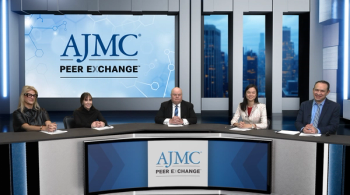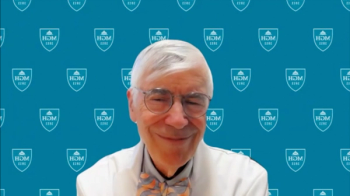
Guidelines for the Management of Osteoporosis
Peter L. Salgo, MD: Let’s talk about the National Osteoporosis Foundation. Funny we should talk about that.
Claire Gill: Yes.
Peter L. Salgo, MD: What are their guidelines? What do they recommend about nationality, comorbidities? What are your goals?
Claire Gill: We don’t actually put out specific guidelines. What we have is a clinician’s guide. The clinician’s guide provides clinical guidance where there may not be guidelines that we need. Dr Singer can talk to you more about what the actual guidelines say, and they’re available on our website. They’re being updated right now. It’s free. We have a mobile app, etcetera, so it makes it easy for clinicians in a certain situation to come to the National Osteoporosis Foundation and find what they need.
Peter L. Salgo, MD: Do you remember your website?
Claire Gill: I do. It’s www.nof.org.
Peter L. Salgo, MD: So they can go there and they can get all of this information. What are you looking to do? Are you looking to prevent all osteoporosis, or find all osteoporosis? That’s different, isn’t it?
Claire Gill: It is. I think we’re really looking to get those who are at highest risk. And like I said, Dr Singer might want to take on what the guidelines actually say.
Andrea J. Singer, MD, FACP, CCD: Sure. I think there are 2 aspects. One is talking about secondary prevention. That’s looking at the group who’s already had that first fracture. In some ways, we could think about them as the low hanging fruit. They’ve already declared themselves. They’re kind of waving a flag at us saying, “I’ve had a fracture. Notice me.” That’s a group for which there’s very little controversy that we should pay attention to and treat. The second issue is primary prevention—trying to cast a wider net and find patients who are at high risk and have not yet had that fracture. In an ideal world, we would be doing both. When we talk about constrained resources and all of those things, I think the goal is to sort of start with the highest risk group, particularly those who’ve fractured, and then work out beyond that.
Peter L. Salgo, MD: I want to ask something that I think comes out of left field. Nationality. Are there some ethnicities that are at higher risk? Should we be triggering earlier on some folks than others?
Claire Gill: Yes.
Peter L. Salgo, MD: For example?
Claire Gill: Well, I’ll let the doctors give the examples, but....
Andrea J. Singer, MD, FACP, CCD: If we look at least within the United States, of Caucasians, Hispanics, African Americans, and Asians, Caucasian women tend to be at highest risk. African Americans, out of those 4 groups, tend to be at lowest risk because they tend to reach higher peak bone densities and have more dense bones. And then Hispanics and Asians fall in between. So there are some ethnic differences. Family history and genetics are important. But that alone is not the full driver. We have to look at it in the context...osteoporosis does not spare any race, and it does not spare either gender.
Peter L. Salgo, MD: Now, there are guidelines, right? There are clinical guidelines for physicians. Do doctors follow them?
Thomas P. Olenginski, MD, FACP, CCD: Most doctors don’t like guidelines.
Peter L. Salgo, MD: Are they aware there are guidelines?
Thomas P. Olenginski, MD, FACP, CCD: Yes. I’m going to talk about what I’ve seen at our institution. I’m proud of our institution because in no way do I think primary care physicians [PCPs] don’t understand this. Their challenge is their practice landscape and the time, and the pressures of being a busy primary care physician. So if we talk about use of DEXA [dual energy x-ray absorptiometry], and doing the right thing after the DEXA report, our primary care physicians, in 2 analyses, 3 out of 4 times get a DEXA, the patient falls into a higher risk group, and they place the patient on the therapy. What happens is bisphosphonates are not easy to take. In anyone’s hands, at 1 or 2 years, they’re not always getting taken continuously. I think where guidelines are challenging for primary care physicians would be based on this general sense that a patient at risk needs to be treated for 3 to 5 years. Well, what happens after that, if there are other risks? And I think that’s where subspecialty care, and patients, and practices really devoted to high-risk patients can help. But I think….
Peter L. Salgo, MD: Are there enough subspecialists?
Andrea J. Singer, MD, FACP, CCD: No, and let me make a couple of comments as a primary care physician. I’m still an in-the-trenches primary care doctor, although I obviously do a lot of bone. So I sort of think of myself as a PCP bonehead. But only I can call myself that, you cannot. As Tom mentioned, part of the issue is competing priorities. When a patient comes in to see their primary care doctor with 7 problems on their list for the day, or they have diabetes, heart disease, hypertension, osteoporosis falls down here somewhere. We need to say, “I can’t get to everything today, but I’m going to bring you back in to talk about this.” It’s also not that doctors, in general, and primary care providers don’t want to do the right thing. They do, but other things get in the way. There are also multiple sets of guidelines out there issued by different societies, and they don’t all make the same recommendations. So it becomes a bit of this decision paralysis. You know, if you have too many recommendations coming at you and the experts can’t agree, “I don’t know what to do.” So the path of least resistance is to do nothing.
Peter L. Salgo, MD: What I hear from primary care physicians is, “I’ve got a stack. If I were to stack them on my desk, because now it’s in my computer, it would be this high. I’ve got the urology guidelines, I’ve got the heart guidelines, the lung guidelines. I’ve got guidelines about which guidelines are the right guidelines, and sitting in there is your guideline.”
Claire Gill: That’s right.
Peter L. Salgo, MD: “Which of these do I have to follow? And if I follow all of them, I’ll see 1 patient a day.”
Thomas P. Olenginski, MD, FACP, CCD: I think what you have to do, and what all of us have to do in our institutions, in our community is try to understand how we can make it a little bit easier. We try to do that by interpreting DEXA the way we were told by our primary care physicians that they wanted it, and one of the major reasons that I would say a relatively straightforward osteoporosis referral comes to us is really because, as Dr Singer said, they are competing with time. They just don’t have enough time to explain. It’s not that they don’t know what to do. We can just focus on that 1 issue. We have the time to do that.
Newsletter
Stay ahead of policy, cost, and value—subscribe to AJMC for expert insights at the intersection of clinical care and health economics.



























































